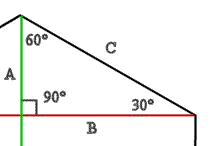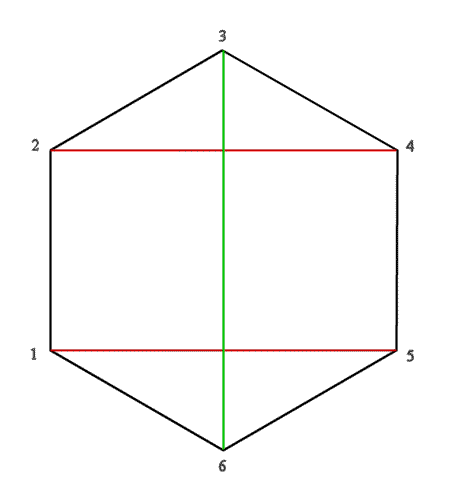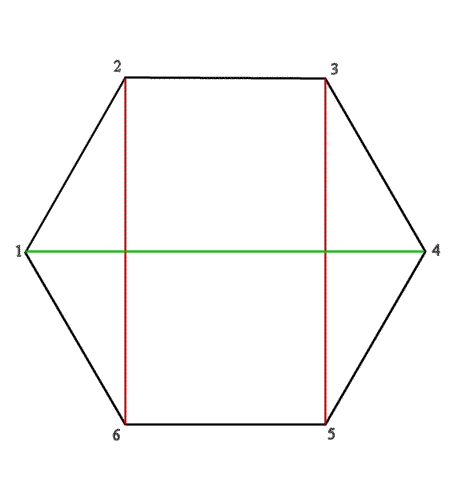Drawing Hexagons
Introduction
Many tabletop role playing games use a map drawn on hexagons to
show where players and other objects are. They do this because
hexagons have an equal distance from center to center, any way you
go, where squares do not.
Unfortunately, drawing squares on the screen is lots easier than
drawing hexagons. Hit-detection and positioning are simpler too, so
most computer programs wind up using squares, or at the least,
rectangles. While this is perfectly acceptable, it's not as
effective, and offers a different gaming experience.
There are many interesting resources on the web to handle gaming.
Some of them talk about using hexes, but don't talk about how to
actually draw them, or how to do anything useful like hit testing.
Probably, if you're not as math-impaired as I am, this is a
straightforward thing to do, and you'll have no trouble. However, it
took me some doing, and I thought I'd write it up here so that
someone else might not have to do the same.
Representing Hexes
There are several suggestions on how to store the contents of
hexagons on a web page I can't find the URL to at the moment. I found
most of them more complex than need be, and discovered that storing
the contents of the hexes in a two dimensional array worked best. A
grid of hexes really is just grid, but with a row offset by half a
hex. Storing this is much simpler than the other suggestions I read.
My friend tangaloor helped a lot in getting my brain around this.
He and I developed a quick way to draw hexes which wasn't quite
spot on, and drew irregular hexes. The
thinking I did there led me here.
Drawing Hexes
How I Figured It Out
Drawing a real, regular hexagon baffled me for a long time. I
finally sat down with some graph paper, some pencils, and some hex
paper and started making scribbly notes. What I finally realized, is
that a regular hexagon could be broken up in to a rectangle, and four
right triangles. Once I knew this, it came together pretty well.

This
hex shows the triangles I'm talking about. The angles are reasonably
easily fathomed; each interior angle of a regular hexagon is a 120
degree angle, and we know that the red lines are perpendicular to the
green line; it must be a 30-60-90 triangle, and identifying the 30
and 60 degree sides are pretty straightforward.
Once you've broken the hex in to nice triangles, it becomes a
little easier how to see the things you want to know. In a regular
hexagon, all the sides are the same length. Extracting one triangle,
and labeling the sides gives us some names to work with.

If
you look at the full hex above, you'll see that if you know the
lengths of all three sides of this triangle, you can plot points on a
grid to draw a hexagon pretty easily. And, since we know one of the
lengths of the sides, we can get the rest through some good old
fashioned trigonometry.
We need to know A, B, and C. We are given C.
We can calculate side A from this:



That's a pretty reasonable formula.
The other is similar, but doesn't boil down to such nice clear
numbers:


Sin 60 is a constant, though, which can be evaluated, or stored as
a constant (0.866) in your program to whatever degree of accuracy you
feel the need to use.
That is:


 (given)
(given)
Drawing a Hex
To actually draw a hex, you need to figure out the points for each
point of the hex. There are two ways of drawing a hex, one, called
North-South, has the parallel edges running vertically on the page.
The other, called East-West has the parallel edges running
horizontally. Using the lengths above, it becomes pretty
straightforward to calculate points for the hex.
I have numbered the points of the hex simply to show which is
which; the numbers have no real bearing on anything.
North-South
A North-South hex can be drawn by using the following points.

|
Point
|
X Coordinate
|
Y Coordinate
|
|
1
|
0
|
A + C
|
|
2
|
0
|
A
|
|
3
|
B
|
0
|
|
4
|
2 * B
|
A
|
|
5
|
2 * B
|
A + C
|
|
6
|
B
|
2 * C
|
East-West
An East-West hex can be drawn using the following points.

|
Point
|
X Coordinate
|
Y Coordinate
|
|
1
|
0
|
B
|
|
2
|
A
|
0
|
|
3
|
A + C
|
0
|
|
4
|
2 * C
|
B
|
|
5
|
A + C
|
2 * B
|
|
6
|
A
|
2 * B
|



